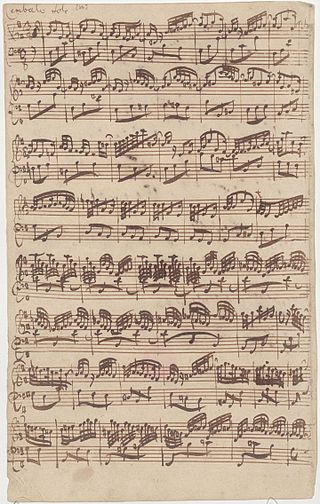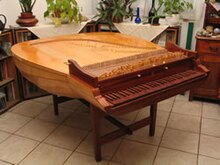The Italian Concerto, BWV 971, originally titled Concerto nach Italiænischen Gusto, is a three-movement concerto for two-manual harpsichord solo composed by Johann Sebastian Bach and published in 1735 as the first half of Clavier-Übung II. The Italian Concerto has become popular among Bach's keyboard works, and has been widely recorded both on the harpsichord and piano.

The English Suites, BWV 806–811, are a set of six suites written by the German composer Johann Sebastian Bach for harpsichord and generally thought to be the earliest of his 19 suites for keyboard, the others being the six French Suites, the six Partitas and the Overture in the French style. They probably date from around 1713 or 1714.

The French Suites, BWV 812–817, are six suites which Johann Sebastian Bach wrote for the clavier between the years of 1722 and 1725. Although Suites Nos. 1 to 4 are typically dated to 1722, it is possible that the first was written somewhat earlier.

Bourrée in E minor is a popular lute piece, the fifth movement from Suite in E minor BWV 996 written by Johann Sebastian Bach between 1708 and 1717. The piece is arguably one of the most famous among guitarists.
Johann Sebastian Bach composed suites, partitas and overtures in the baroque dance suite format for solo instruments such as harpsichord, lute, violin, cello and flute, and for orchestra.
The Overture in the French style, BWV 831, original title Ouvertüre nach Französischer Art, also known as the French Overture and published as the second half of the Clavier-Übung II in 1735, is a suite in B minor for a two-manual harpsichord written by Johann Sebastian Bach.

Peter Watchorn is an Australian-born harpsichordist who has combined a virtuosic keyboard technique, musical scholarship and practical experience in the construction of harpsichords copied from original instruments of the 17th and 18th centuries. As well as presenting many solo public performances and broadcasts of baroque keyboard music and participating in choral and orchestral performances, he has made numerous commercial CD recordings of solo harpsichord music from the 17th and 18th centuries.
The Sonata in A major for transverse flute and harpsichord by Johann Sebastian Bach is a sonata in 3 movements:
The Sonata in C major for flute and basso continuo is a sonata in 4 movements. It is attributed to Johann Sebastian Bach in the manuscript, which is in the hand of his son Carl Philipp Emanuel Bach and has been dated to about 1731, although scholars question the attribution

The Bach-Busoni Editions are a series of publications by the Italian pianist-composer Ferruccio Busoni (1866–1924) containing primarily piano transcriptions of keyboard music by Johann Sebastian Bach. They also include performance suggestions, practice exercises, musical analysis, an essay on the art of transcribing Bach's organ music for piano, an analysis of the fugue from Beethoven's 'Hammerklavier' sonata, and other related material. The later editions also include free adaptations and original compositions by Busoni which are based on the music of Bach.

The Prelude in C Minor, BWV 999, is, according to its only extant 18th-century manuscript, a composition for lute by Johann Sebastian Bach. In the manuscript, conserved as Fascicle 19 of Mus.ms. Bach P 804 at the Berlin State Library, Johann Peter Kellner wrote the piece down in keyboard notation. The time of origin of the work is not known: possibly Bach composed it in his Köthen period, that is, between 1717 and 1723, or the early years of his ensuing Leipzig period. Kellner's copy was produced after 1727, but before Bach's death in 1750.

The Well-Tempered Clavier, BWV 846–893, consists of two sets of preludes and fugues in all 24 major and minor keys for keyboard by Johann Sebastian Bach. In the composer's time, clavier referred to a variety of stringed keyboard instruments, most typically the harpsichord or clavichord, but not excluding the organ, although it is not a stringed keyboard.
Suite in E minor, BWV 996, is a musical composition written by Johann Sebastian Bach (1685–1750) between 1708 and 1717. It is probable that this suite was intended for Lautenwerck (lute-harpsichord). Because the lautenwerk is an uncommon instrument, it is in modern times often performed on the guitar or the lute.
Prelude, Fugue, and Allegro in E-flat major, BWV 998, is a musical composition written by Johann Sebastian Bach for Lute or Harpsichord. The piece was written around 1735. The original manuscript with the title "Prelude pour la Luth. ò Cembal. Par J.S. Bach" was sold at Christie's on July 13, 2016, for £2,518,500.

The Partita for keyboard No. 6 in E minor, BWV 830, is a suite of seven movements written for the harpsichord by Johann Sebastian Bach. It was published in 1731 both as a separate work and as part of Bach's Clavier-Übung I.
The Suite in C minor, BWV 997, by Johann Sebastian Bach, exists in two versions:

The Toccatas for Keyboard, BWV 910–916, are seven pieces for clavier written by Johann Sebastian Bach. Although the pieces were not originally organized into a collection by Bach himself, the pieces share many similarities, and are frequently grouped and performed together under a collective title.











